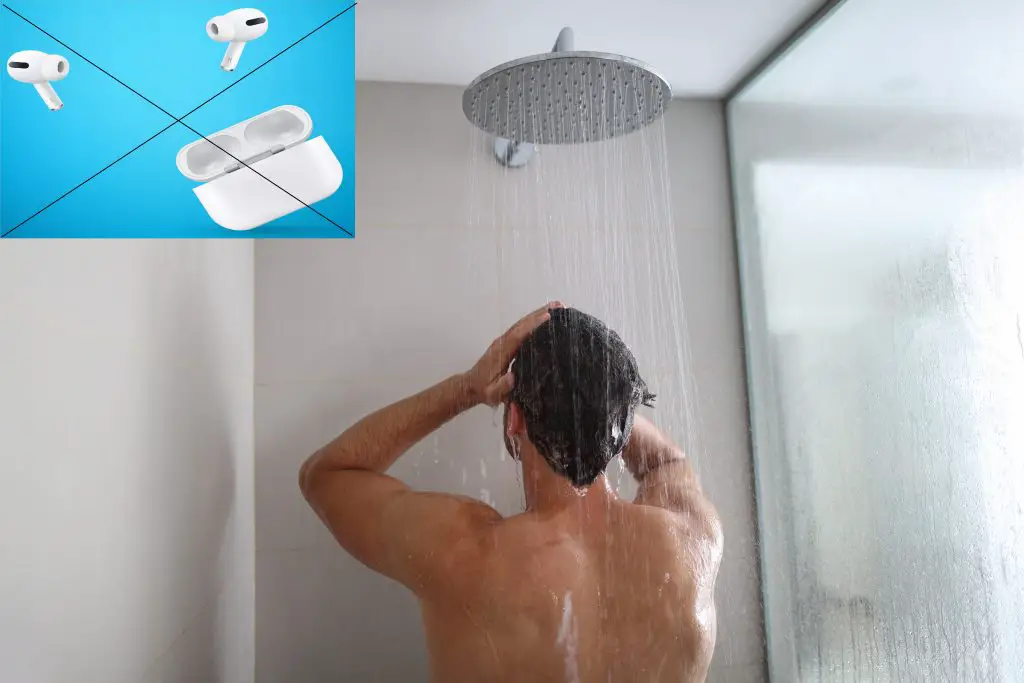Do you love a long shower?
And while you’re showering, do you want to listen to your favorite music or podcast? Wouldn’t it be great if you could keep listening as you shower without having to take off your AirPods?
Alas. This is not a good idea.
Because. Straight up.
You’re most unlikely to have your AirPods working by the end of the shower.
So the short answer is. You can’t wear your AirPods in the shower, and it’ll be an expensive and wasteful experience if you do.

In this post, you’ll find out the ins and outs of why it’s not a good idea, look at what to do if you do get your AirPods wet, and, if you can, wear them around water at all.
First up, let’s look at why it’s not a good idea.
Why Not Wear Your AirPods in the Shower?
IPX rating is what it comes down to.
Water-resistant but not waterproof, the Apple AirPods Pro has an IPX4 rating. Unfortunately, standard AirPods don’t even have an IP rating, so they have no protection from water intrusion at all.
An IPX4 rating, you ask?
And
what’s the difference between waterproof and water-resistant?
Let’s find out.
What Are IPX Ratings?
The IP in the term IPX is short for ‘Ingress Protection’ (or “protection from intrusion”).
IP ratings are standards set by the International Electrotechnical Commission (IEC) based in Geneva, Switzerland. The standards apply to electronics for consumer and industrial use. So all the devices we use in our daily lives can be tested and given a standard IP rating.
The IP rating structure is IPXXX.
The first X is a rating for dust resistance and protection on a scale of 0 to 6.
The second X is the rating for water intrusion and protection with a scale of 0 to 9
The third X is optional and not used often. Alphabetic characters are used for this rating to indicate the quality of or other types of protection. For example, C is for protection from tools, and D protection from wires. F means resistance to oil, and H is used to identify a high voltage device. M is for the device moving during water testing, while S is when the device is standing still. Finally, W refers to weather conditions during the testing.
You can refer to my comprehensive IP Ratings Guide for full details of the dust and water IPX Rating scales.
An X for the first or second value means the device has not been tested for dust or water resistance, respectively. The third X is not included in the IP code if not applicable.
The rating IPX4 means the device has not been tested for dust and guards against water splashes at any angle or direction. In addition, it is used to indicate that the device is “sweat-resistant.” I’ll come back to this description later as it applies to AirPods.
So the AirPods Pro are both sweat-resistant (beads of sweat) and resistant to splashes of water.
But water resistance is not the same as waterproof, which leads us to consider why this is the case and why the difference matters.
Waterproof vs. Water-Resistant – Why does this matter?
Water resistance protects occasional and slight exposure to water (light splashes or a dash through light rain) but not continuous exposure to moisture like in the shower.
Without full waterproofing, water will enter into the AirPods casing and short circuit the wiring. Even extended exposure to moisture, like relaxing in a sauna, can have the same effect.
A waterproof device, on the other hand, is not affected by water. Therefore, it can be fully submerged and continue to work. As a result, you can use them in the shower, when swimming, or even drop them in the pool. Such devices have an IP rating of IPX7 or IPX8.
So wearing AirPods in the shower is a definite “nono.”
But there are different types of AirPods, and sometimes folks wonder whether the premium AirPods Pro offers a higher degree of water protection.
AirPods vs. AirPods Pro – Does it make a difference?
There are differences in the design and features between the standard AirPods (1 & 2) and the AirPods Pro. However, here I’ll only focus on their water-resistant capabilities.
As mentioned earlier, standard AirPods have no IP rating, so even heavy sweating or water splashes could mean they short circuit and stop working.
The AirPods Pro at least “are sweat and water-resistant for non-water sports and exercise” with an IPX4 rating.
As I highlighted before, there is no protection with the IPx4 rating from using AirPods Pro in the shower.
And even the sweat-resistant and water-resistant capabilities have their limits.
What about the sweat and water resistance of AirPods Pro?
Sweat and water resistance applies only to temporary conditions and not permanent conditions. Temporary needs like a heavy workout, a long run or walk, or a splash of water at the pool. In these circumstances, there’s enough protection to prevent moisture from affecting the AirPods Pro.
But don’t leave them moist. Instead, dry your Apple AirPods Pro after use. Only dry though by using a soft, dry, lint-free cloth. It’s not wise to use heat or compressed air.
Drying them after use will reduce the exposure time of the seals to moisture. However, over time the water-resistant seals will degrade. So you’ll need to be more careful using your AirPods Pro as their water resistance reduces with age.
Sometimes though, accidents happen.
What can you do if your AirPods get wet?
Use a microfiber cloth to dry the wet AirPods immediately after getting them wet. It’s essential to ensure that you get all of the water off-dry, even the tiniest opening.
Drying them limits the amount of water that enters the cracks and holes and reduces the resulting water damage to the wiring inside.
Remember to avoid using a radiator or blow-dryer as they could overheat the AirPods. And under no circumstances should the still damp AirPods be put in their charging case.
The devices are drying, so you don’t want to introduce external electricity. Drying can take some time, so keep them inactive as long as you can (24 hours is best).
Can other liquids damage your AirPods?
Yes, they can. Liquids such as body wash, shampoos, and conditioners are just as destructive as water.
And the heavy moisture of the sauna, shower area, or steam room is equally as damaging.
What about wearing AirPods straight after the shower?
You could argue that the bathroom after a shower is similar to a steam room—warm, damp, and wet conditions.
It’s probably best that you avoid using the AirPods in the bathroom at all.
If you have to, keep the extractor going, perhaps open the door to let in dry air, and make sure you’re hair and ears are thoroughly dried.
What if you shower with your AirPods by mistake – is it dangerous?
Only to the AirPods. The voltage is so low that you won’t electrocute yourself.
Can’t get them working again – does Apple’s Warranty cover them?
The standard Apple warranty covers you for the first year after you purchase your AirPods. But this warranty doesn’t cover water damage.
If you purchased AppleCare+ for Headphones ($29 for two years coverage within 60 days of buying your AirPods or AirPods Pro), you pay an AppleCare+ service fee of $29 (per incident). So if you have to replace both AirPods or AirPods Pro, it will cost $58.
These fees increase if you are out-of-warranty:
- AirPods are $69 per incident ($138 for two)
- AirPods Pro are $89 per incident ($198 for two)
- And both are subject to tax and a shipping fee of $6.95.
